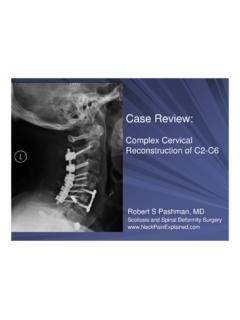Transcription of Various Complications of Complex Regional Pain …
1 1 Various Complications of Complex Regional pain Syndrome (CRPS) H. Hooshmand, and Eric M. Phillips Neurological Associates pain Management Center Vero Beach, Florida Abstract: Complex Regional pain syndrome (CRPS) is an unrelenting pain syndrome that affects millions of people world wide. Most patients display the common signs and symptoms of CRPS. When patients have suffered for many years to decades they may develop many Various Complications of the disease. In this article we will discuss many of the Various Complications that are associated with CRPS. Key words: Complex Regional pain Syndrome (CRPS), Internal Organ Involvement, Spread of CRPS, Various Complications of CRPS. INTRODUCTION There are Various ways Complex Regional pain syndrome (CRPS) can develop.
2 Onset of this disease is usually caused by a minor trauma, soft-tissue injury ( sprain ankle or wrist); other such causes are crush injuries, surgery, repetitive stress injury (RSI), electrical injuries (EI), and in some cases venipuncture injury (VP CRPS II) (1-4). Spread of the disease and internal organ involvement has also been reported in many patients who suffer from late stages of the disease (5-9). HISTORY OF CRPS The Various symptoms that make up CRPS, and later, the formal naming of this medical condition, have been well documented throughout history. Ambroise Pare was one of the first to describe what is now called CRPS, through his account of the persistent pain that King Charles IX had suffered from in the 16th century (10).
3 In the late 1700 s British surgeon Sir Pervcivall Pott recognized burning pain and atrophy in injured extremities (1, 11). In 1813 Denmark reported a single case of a soldier who had an amputation due to burning pain (1, 12, and 13). In 1838 Hamilton had seen some cases in which his patients had symptoms of causalgia which resulted from accidental nerve injuries (14). Early in 1864 Paget had patients who had symptoms of constant warmth in their limb after nerve injury (15). Also, in 1864 Silas Weir Mitchell the father of American neurology gave the description of causalgia in his classic article Gunshot Wounds and Other Injuries of Nerves, but it was not until 1867 when he coined the term of causalgia from the Greek words, "Kausos" (heat) and "algos" ( pain ) to describe this syndrome (16).
4 Since Mitchell s first description of this painful syndrome, there have been many other names giving to this awful disease. In 1900 Sudek named it Sudeck atrophy; in 1937 DeTakats named it Reflex Dystrophy; in 1947 Steinbrocker named it Reflex Neurovascular Dystrophy and Shoulder-Hand Syndrome; in 1947 Evans named it Reflex Sympathetic Dystrophy (RSD); and in 1994 Merskey, et al. named it Complex Regional pain Syndrome (CRPS) (17-21). STAGES OF CRPS CRPS has been divided into four different stages. Depending on nature of injury, the stages vary in their duration. In the 17 patients suffering from venipuncture CRPS in our series, deterioration from stage I to stage III was measured in a few weeks up to less than 9 months.
5 This is in contrast with CRPS in children in whom stages would stagnate, reverse or improve slowly (2,22). Stage I, is a sympathetic dysfunction with typical thermatomal distribution of the pain . The pain may spread in a mirror fashion to contralateral extremity or to adjacent regions on the same side of the body (9). In stage one; the pain is usually SMP in nature. In stage II, the dysfunction changes to dystrophy manifested by edema, hyperhidrosis, neurovascular instability with fluctuation of livedo reticularis and cyanosis - causing change of temperature and color of the skin in matter of minutes. The dystrophic changes also include bouts of hair loss, ridging, dystrophic, brittle and discolored nails, skin rash, subcutaneous bleeding, neurodermatitis, and ulcerative lesions.
6 2 Due to the confusing clinical manifestations, the patient may be accused of factitious self-mutilation and "M nchausen syndrome (2,23)." All these dystrophic changes may not be present at the same time nor in the same patient. Careful history taking is important in this regard (2,24). In stage III, the pain is usually no longer SMP and is more likely a sympathetically independent pain (SIP). Atrophy in different degrees is seen. Frequently, the atrophy is overshadowed by subcutaneous edema. The Complex Regional pain and inflammation spread to other extremities in approximately one-third of CRPS patients (24-26). At stage II or III it is not at all uncommon for CRPS to spread to other extremities (2,9,22,27). At times, it may become generalized.
7 The generalized CRPS is an infrequent late stage complication (2,9). It is accompanied by sympathetic dysfunction in all four extremities as well as attacks of headache, vertigo, poor memory, and poor concentration. The spread through paravertebral and midline sympathetic nerves may be vertical, horizontal, or both (2, 9, 27-29). The original source of CRPS may sensitize the patient to later develop CRPS in another remote part of the body triggered by a trivial injury. The ubiquitous phenomenon of referred pain to remote areas ( , from foot or hand to spine) should not be mistaken for the spread of CRPS. At stage III, inflammation becomes more problematic and release of neuropeptides from c-fiber terminals results in multiple inflammatory and immune dysfunctions.
8 The secondary release of substance P may damage mast cells and destroy muscle cells and fibroblasts (30-33). Stage IV identifies the final stage of CRPS manifested by (1, 2): Failure of the immune system, reduction of helper T-cell lymphocytes and elevation of killer T-cell lymphocytes. Intractable hypertension changes to orthostatic hypotension (34). Intractable generalized edema involving the abdomen, pelvis, lungs, and extremities. Ulcerative skin lesions which may respond to treatment with Mannitol, Immunoglobulin, and ACTH treatments. Calcium channel blockers such as Nifedipine may be effective in treatment (35). High risks of cancer and suicide are increased. Multiple surgical procedures seem to be precipitating factors for development of stage IV.
9 Stage IV is almost the flip side of earlier stages, and points to exhaustion of autonomic and immune systems. Ganglion blocks in this stage are useless and treatment should be aimed at improving the edema and the failing immune system. Sympathetic ganglion blocks, alpha blockers, including Clonidine, are contraindicated in stage IV due to hypotension. Instead, medications such as Proamantin (midodrin) are helpful to correct the orthostatic hypotension (2,36). With passage of time, and types of treatment, CRPS goes through stages with variable time tables and sympathetic responses (5) (Table I). 3 Table I. Stages, Signs and Symptoms of CRPS Stages Signs / Symptoms Stage I: Dysfunction Hyperpathia; allodynia; muscle weakness; flexor spasms; thermal changes Stage II: Dystrophy Edema; skin; hair and nail changes Stage III: Atrophy Muscle atrophy; neurovascular instability; cutaneous rash or skin ulcers Stage IV: Irreversible disturbance of plasticity; autonomic failure Systemic autonomic failure; visceral edema; irreversible low BP; MRSA; elephantiasis; cancer Various Complications OF CRPS Most patients suffer from the standard signs and symptoms of the disease.
10 Over time a majority of patients that have suffered for many years to decades do develop Various Complications of the disease. Over the years we have recognized a large array of Various Complications associated with CRPS which often go untreated. Many of these Complications are not well recognized by the medical community treating CRPS patients. However, CRPS continues to be a very Complex disease to understand and to treat. These Various Complications can impede the proper treatment for spread of the disease and the underlying issues that arise from these Complications . It is very well known that during the long duration of the disease when patients reach stage IV, they start to develop Various Complications such as disturbance of the immune system (neurogenic inflammation), limbic system, cardiac system, endocrine system, and the respiratory system.









